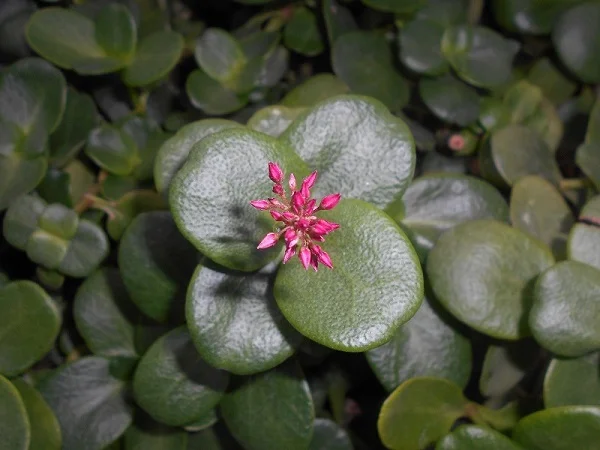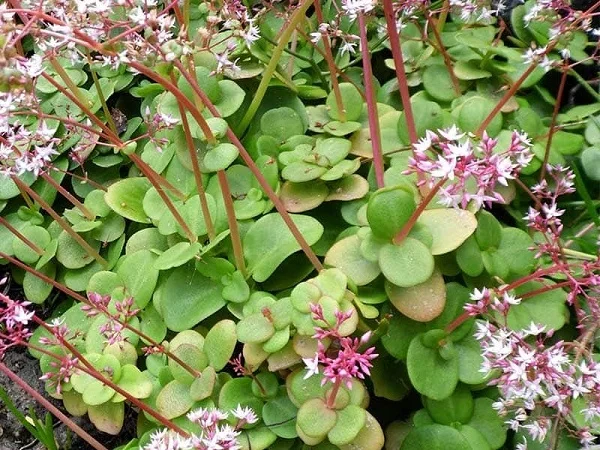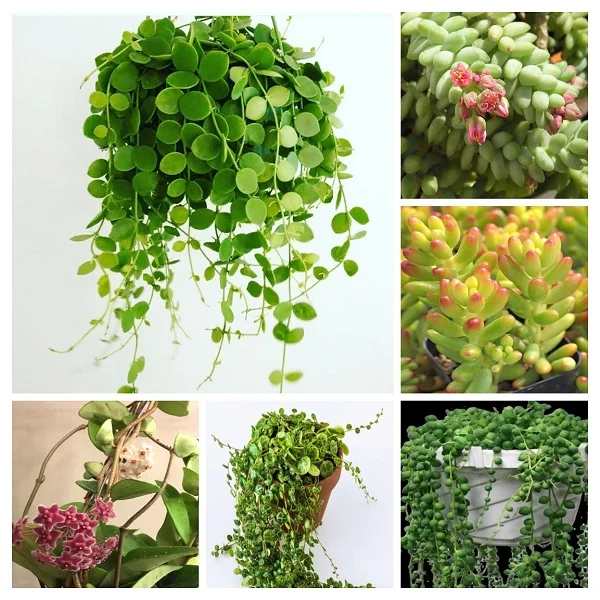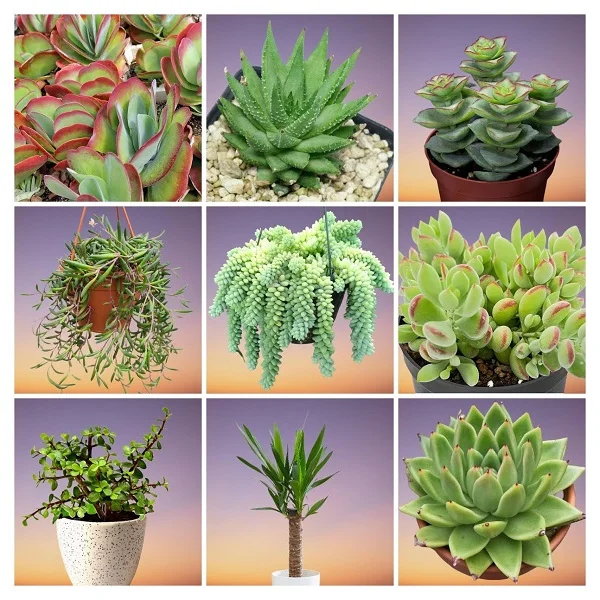Fairy Crassula multicava Care Indoors, Propagation, Common Problems & Remedies
Some links in this post may be affiliate links
Fairy Crassula multicava thrives in bright light with some direct sunlight, average warmth, moderate humidity and moderately moist, rich, well-drained soil coupled with monthly feeding in the growing season.
Crassula multicava also called Pitted Crassula, Crassula Fairy or London Pride is among the popular Crassula varieties and bears glossy, round leaves with tiny pores along the edges.
The small pores along the leaf edges are hydathodes which allow moisture absorption from the air. It is an important feature in its natural habitat where the conditions are generally dry. The species name, 'multicava', which means 'many caves', is in reference to the tiny pores or pits on the leaves.
Pitted Crassula is a mat-forming succulent plant whose leaves are borne in opposite pairs on the stems and are a lighter green color in good lighting and a darker green in shady conditions.

Botanical name: Crassula multicava
Synonym: Septimia multicava, Crassula quadrifida
Family: Crassulaceae
Common names: Fairy Crassula, Pitted Crassula, Crassula Fairy, London Pride, Cape Province Pygmy Weed, Mosquito Flower
Origin
Crassula multicava also called Septimia multicava or Crassula quadrifida is native to southern Africa in the mountainous regions, river and streams banks, coastal and subtropical thickets.
Size
Crassula Fairy is a mat-forming plant which can grow to a height of about 1 foot. It blooms from late winter to early spring though it is unlikely to flower indoors.
Flower
Fairy Crassula flowers are small, star-shaped borne above the foliage and are attractive to bees. They start off as pink buds which open into white stars. The common name, 'Fairy Crassula', is in reference to the beautiful, tiny, star-shaped flowers.
Invasiveness
Fairy Crassula is considered invasive in Australia and other warm regions. The plant bears tiny plantlets on the flower stem which drop and grow into new plants.
Pitted Crassula can successfully compete with native species in these regions as it can form dense mats which choke out other plants. Avoid growing Crassula multicava in the ground as it may be dificult to control. The plant is beautiful in a hanging basket.
Is Crassula multicava toxic?
Yes. Crassula multicava like its cousin, Jade Plant, is considered toxic to both humans and pets as indicated by ASPCA. If ingested it can cause nausea, vomiting and diarrhea. Keep the plant away from the reach of children and pets.
How do you care for Crassula multicava indoors?
To care for Fairy Crassula multicava indoors, provide bright light with 4-6 hours of direct sunlight, average warmth of 15-240, humidity of 50-55% and moderately moist, rich, well-drained soil coupled with monthly feeding in spring and summer.
Crassula Fairy care has no need for regular repotting as it grows best when pot-bound. Pruning is required to keep the plant neat, to discourage pest and disease infestations and to rejuvenate growth. Keep reading for more on these growing conditions and how to achieve them.

Light Requirements
Fairy Crassula grows best in bright light with at least 4-6 hours of direct sunlight. Keep it away from too hot midday sunshine to avoid scorching of the leaves.
If the light is not sufficient, the plant will become leggy with elongated stems, wide spaces between the leaf nodes and small pale leaves. Where the natural lighting is not adequate, use a full spectrum grow light to supplement it.
Regularly rotate the pot to make sure that the plant receives light on all sides for even growth and to prevent leggy growth.
You can also grow the Crassula Fairy outdoors, however, gradually acclimate it and place it in a shaded place to prevent scorching the leaves.
Watering
Water your Fairy Crassula deeply in spring and summer while allowing the top half of soil to dry out between waterings. keep the soil moderately moist and avoid overwatering to prevent rotting, yellowing and leaf drop.
Cut down on watering in fall and winter to maintain the soil barely moist as growth is reduced. Do not let the soil dry out completely to prevent wilting, yellowing and leaf loss.
Only use water that is at room temperature to avoid cold shock which can cause stunted growth and sudden leaf drop.
Ascertain that the pot has a drainage hole and the soil is free-draining to prevent waterlogging as it can result in rotting and death of the plant.
Take care not to wet the foliage while watering as it can lead to fungal diseases. You may water from the bottom instead.
Temperature & Humidity
Fairy Crassula prefers an average warmth of 15-240 with a minimum of 100C in fall and winter. Keep it away from sources of drafts like windy windows and doors, AC units, heat sources and others as they can cause stunted growth, brown leaf spots and leaf fall.
Crassula multicava prospers in a humidity of 50-55%. Ensure that there is good air circulation to prevent fungal disease infestations.
Fertilizer
Feed your Crassula Fairy with a cactus and succulents fertilizer monthly in spring and summer for a lush, healthy growth. Take care not to overfeed as the plant is a slow grower.
Withhold feeding in fall and winter as growth is minimal at this time and feeding at this time can lead to fertilizer burn and eventual death of the plant.
Potting Soil
Fairy Crassula soil should be loose, rich in organic matter and well-draining to prevent waterlogging. The soil should be loose enough to allow water to drain out quickly. Cactus and succulents soils are ideal for this plant as it drains easily.
Repotting
Repot Crassula multicava at the beginning of the growing season (spring to early summer), only when it becomes confined in its current pot.
Select a pot that is only one size larger than the current one to avoid overpotting. Use a pot that has a drainage hole and well-draining soil to prevent the soil from getting soggy as it can lead to root-rot.
Use a clay pot as it is porous and therefore allows the soil to dry out faster which prevents it from staying wet for too long. Take a look at these terracotta pots with a saucer on Amazon.
Pruning
Pruning Fairy Crassula involves removal of dead or diseased leaves and spent flowers to keep it neat and also discourage pest and disease infestations. Snip the leaves at the base with a sterilized knife or pair of scissors to prevent diseases transmission.
Cutback the plant at the beginning of the growing season if it is too straggly to rejuvenate growth. Minimize the number of cuts as much as possible to avoid unnecessary injuries to reduce disease infestations.
Occasionally clean the leaves by damp-wiping with a soft cloth to get rid of dust and also reduce pest infestations. Take care not to damage the fragile leaves.
Fairy Crassula Propagation
Fairy Crassula is propagated from leaf cuttings, stem cuttings or plantlets borne on the flower stem at the beginning of the growing season when in active growth.
1. Fairy Crassula propagation from leaf cuttings
- Take leaf cuttings complete with the petiole. Allow the leaf cutting to dry out (callus) for a few days to prevent rotting.
- Once calloussed, lay the leaf cutting on moist, free-draining, rooting mix while ensuring that the cut end does not come into contact with the soil to prevent rotting.
- Place the set up in a warm, well-lit place away from direct sunlight to prevent scorching.
- Maintain the soil moist until a new rosette forms at the base of the leaf cuttings.
- Allow substancial growth of the rosette before transplanting the new plants into individual pots after which you can begin routine care.
2. Fairy Crassula propagation from stem cuttings
- Take 3-5 inches stem cuttings from a healthy plant and allow the cutting to dry out (callus) for a few days.
- Once callused, insert the lower cut end of the stem cuttings in moist, well-drained soil.
- Place the set up in a well-lit, warm place away from direct sunlight to avoid scorching.
- Maintain the soil moist until the stem cuttings are rooted. Rooting may take about 4 weeks.
- Allow substancial growth before transplanting the new plants after which routine care can begin.
3. Fairy Crassula propagation from plantlets
- Carefully seperate the plantlet from the mother plant. Select an offset that has several leaves to increase your chances of success.
- Pot the plantlet in its individual pot in moist, free-draining soil.
- Place the pots in a warm, well-lit place away from direct sunlight.
- Maintain the soil moist through out until the new plant is well established after which you can begin routine care.

Fairy Crassula Problems & Fixes
Fairy Crassula multicava problems are leaf drop, leggy growth, pests and diseases among others. Keep reading for more on these problems and how to solve them.
Leaf drop
Leaf drop on Fairy Crassula is due to too little light, drafts, inconsistent watering or cold water.
How to fix it
Too little light: Move the plant to a brighter spot or use a grow light if the natural light is not sufficient.
Drafts: Keep it away from sources of drafts like AC units, drafty windows, hot air vents, windy doors among others.
Inconsistent watering: Water when the top 2-3 inches of soil feel dry but do not allow the soilball to dry out completely. Do not water on a schedule.
Cold water: Use room temperature as too cold water can cause cold shock resulting in leaf loss.
Leggy growth
Leggy growth on Fairy Crassula is caused by too little light or underwatering.
How to fix it
Too little light: Position the plant in a brighter spot or instal a grow light if the natural lighting is not adequate.
Underwatering: Water when the top 2-3 inches of soil feel dry but do not allow the soilball to dry out completely.
Pests
Common pests on Fairy Crassula are scale insects, mealybugs and spider mites.
How to fix it
- Isolate the affected plant to prevent spread to the other plants.
- Treat the affected plant with neem oil or insecticidal soap as per the manufacturers' recommendations.
- Regularly check underneath and between the leaves for these pests and carry out timely control measures.
- Keep the plant well pruned to discourage the pests.
Diseases
Fairy Crassula is prone to the following diseases:
1. Powdery mildew which is prevalent in overwet conditions coupled with poor air circulation.
How to fix it
- Isolate the affected plant to minimize spread to other plants.
- Treat the plant with horticultural oil as instructed by the manufacturer.
- Improve ventilation and make sure that there is free air circulation for the plant.
- Water from the bottom to avoid wetting the foliage to reduce the disease infestation.
- Use a pot with a drainage hole and soil that drains easily to prevent iwaterlogging.
2. Leaf spot disease which is enhanced by poor air circulation coupled with overdamp conditions. It presents as brown, soft leaf spots.
How to fix it
- Isolate the affected plant and treat it with systemic fungicide as per the manufacturer's recommendations.
- Avoid wetting the leaves during watering to minimize the disease infestation; water from the bottom instead.
- Improve the air flow for the plant to discourage the disease.
You liked it? Share on social media.
Related Content
Amazon Associates Disclosure
Homeplantsguide.com is a participant in the Amazon Services LLC Associates Program, an affiliate advertising program designed to provide a means for sites to earn advertising fees by advertising and linking to amazon.com.





